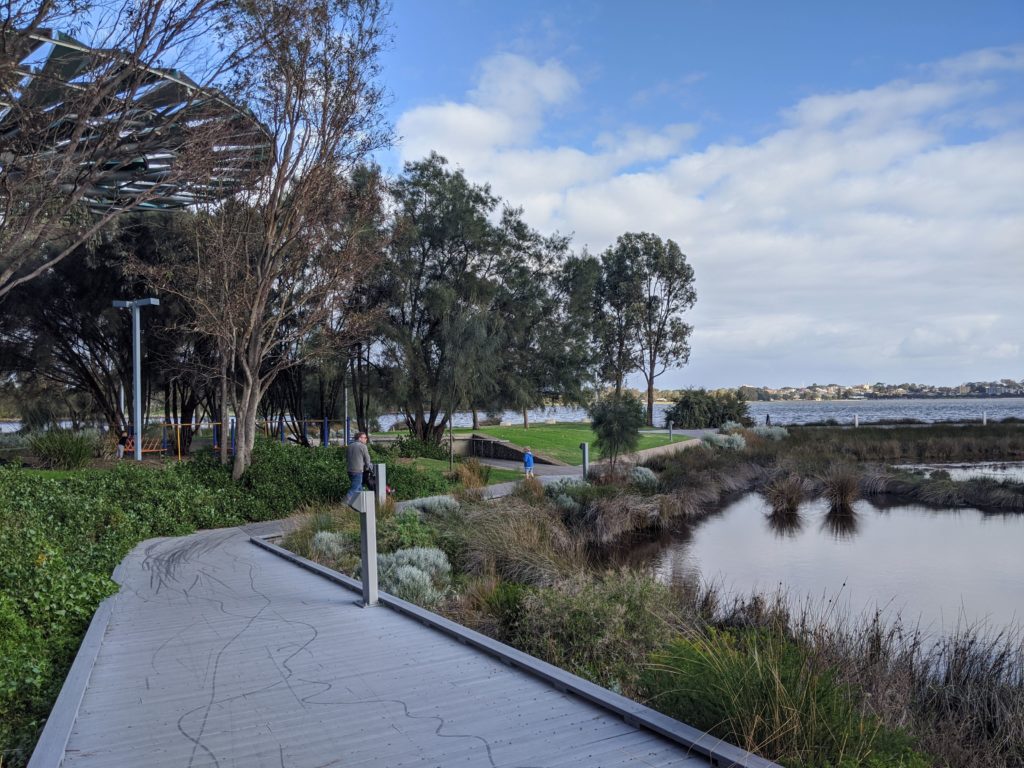
Architect
Syrinx Environmental
Type of Area
Wetland
Large river with natural banks
Land/water interaction
Pier
Embankment
Built Environment Types
Moderately built
Moderate green
Scale of Impact
District/ neighbourhood
City
Regional
Intervention Scale (Spatial)
Linear development – multiple interventions
Project Types
Stormwater management
Habitat creation/restoration
Outdoor Recreation
Urban/ Rural
Inner urban area
Visibility and Openness
Fully enclosed
Fully contained view
A Wetland with a Story
Point Fraser Wetland is a 5.8 hectare site situated at the east end of the Swan River foreshore, in Perth, Western Australia. It is an innovative fusion of a water management project with landscape design. The site was developed to provide a biodiverse wetland habitat capable of dealing with urban storm water run-off, thus improving the quality of the water discharged into the river and to provide well-designed public playgrounds and picnic areas with parking facilities.
Walking through the wetland provides a glimpse to the pre-urbanised river front, giving a temporal feel to the area. Views of the city, however, at the same time anchor the setting into the modern landscape.
This nature-based solution to mitigate stormwater successfully combines form and function. It filters the contaminated water and diverts it away from the city using evapo-transpirational swales. It also incorporates opportunities for recreational activities such as walking, jogging and playing.
The site includes a restaurant and function centre, food outlets and bars and thus is a popular site for weddings and corporate events.
The two-phase project first developed the biofilters with zones for water treatment. In the second phase the swales were created providing areas for seating, play equipment and planting boxes. Indigenous wetland species have been used to improve the aesthetic qualities of the site, which visitors can appreciate through the winding, raised wooden boardwalks that allow them to connect with the natural environment.
Accessibility and safety to the site has been improved with ramps to connect the different levels and boardwalks with edge guides to prevent falls. The site consists of concrete retaining walls, paved surfaces and edges defined in wood and stone.
Viewing platforms, seating areas, grass lawn and litter bins improve the recreational facilities of the area, as do anchoring points for boats and canoes between the swales. Signs provide information on the environmental, historical and indigenous connections of the area and tell the story of the local Nyungar people and their sacred connection to the river.
Perception and Meaning
Imageability
Accessibility
Knowledgeability
Focal point
Health and Wellbeing
Better environmental perception
Increases socialisation
Aesthetic experience
Place affordance
Restorativeness
Interaction with Water
Visual

Website of the project:
https://d3pcsg2wjq9izr.cloudfront.net/files/19643/articles/17311/PointFraser.pdf
Google map reference
The ratings for this site show excellent scores for accessibility. The ratings reflects the local authority’s commitment to accessible green and blue spaces throughout the city and thus the project is also well connected to its surrounding green and blue spaces through a network of pedestrian and cycle paths. The overall design of the site is also high for this popular site. The accessible pathways that fit the surrounding area ensures that people can circulate around the site with ease. The cultural heritage is also high as the site makes space to tell the history of the local indigenous people.
Of particular note are the design features to protect the public from the strong Australian sun, with many covered areas and shade from the trees. The site, however, lacks wind shade as this is balanced with maintaining views to the river. Connection to nature is high as the pathways meander through the wetland, this also lends an atmosphere suitable for contemplation and a sense of being away. Special safety features include the edgings to the pathways.
Maintaining a view of the iconic Swan River is an important feature but as a wetland with stormwater capabilities, the access to the water itself is not encouraged and therefore not designed into this site. There are children’s play areas incorporated into the design that mix man-made play equipment with natural play around the trees, bringing children close to nature through positive interactive play.
